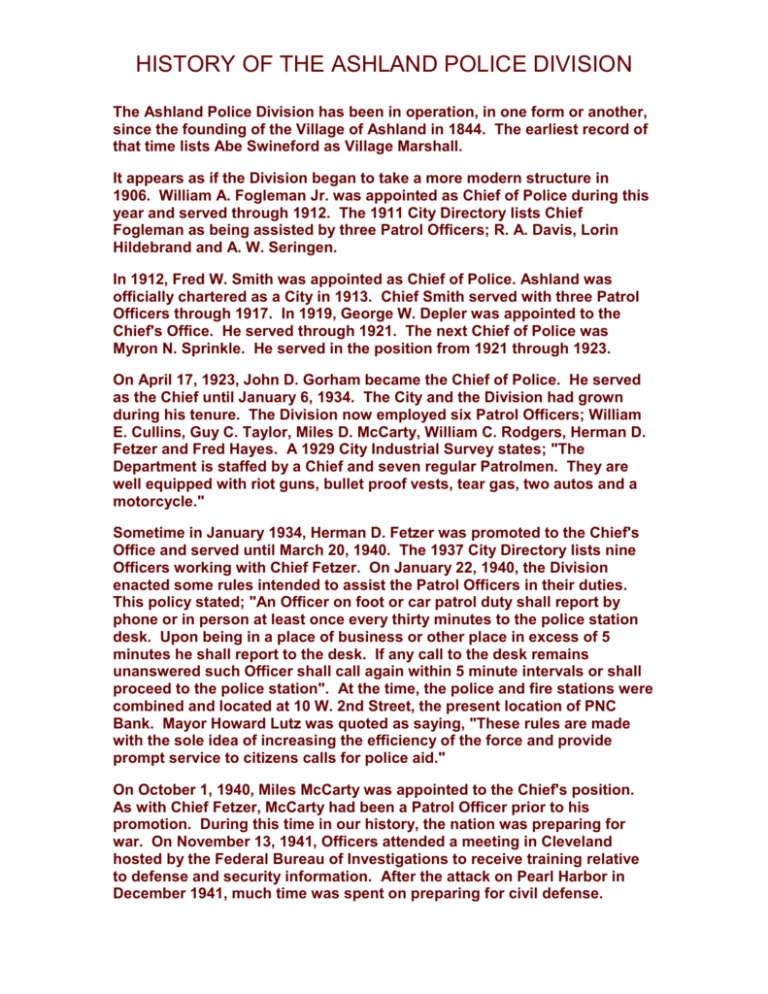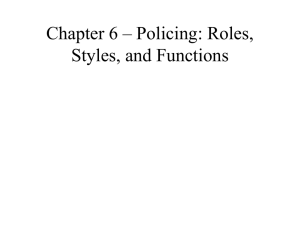ritten history of the ashland police division
advertisement

HISTORY OF THE ASHLAND POLICE DIVISION The Ashland Police Division has been in operation, in one form or another, since the founding of the Village of Ashland in 1844. The earliest record of that time lists Abe Swineford as Village Marshall. It appears as if the Division began to take a more modern structure in 1906. William A. Fogleman Jr. was appointed as Chief of Police during this year and served through 1912. The 1911 City Directory lists Chief Fogleman as being assisted by three Patrol Officers; R. A. Davis, Lorin Hildebrand and A. W. Seringen. In 1912, Fred W. Smith was appointed as Chief of Police. Ashland was officially chartered as a City in 1913. Chief Smith served with three Patrol Officers through 1917. In 1919, George W. Depler was appointed to the Chief's Office. He served through 1921. The next Chief of Police was Myron N. Sprinkle. He served in the position from 1921 through 1923. On April 17, 1923, John D. Gorham became the Chief of Police. He served as the Chief until January 6, 1934. The City and the Division had grown during his tenure. The Division now employed six Patrol Officers; William E. Cullins, Guy C. Taylor, Miles D. McCarty, William C. Rodgers, Herman D. Fetzer and Fred Hayes. A 1929 City Industrial Survey states; "The Department is staffed by a Chief and seven regular Patrolmen. They are well equipped with riot guns, bullet proof vests, tear gas, two autos and a motorcycle." Sometime in January 1934, Herman D. Fetzer was promoted to the Chief's Office and served until March 20, 1940. The 1937 City Directory lists nine Officers working with Chief Fetzer. On January 22, 1940, the Division enacted some rules intended to assist the Patrol Officers in their duties. This policy stated; "An Officer on foot or car patrol duty shall report by phone or in person at least once every thirty minutes to the police station desk. Upon being in a place of business or other place in excess of 5 minutes he shall report to the desk. If any call to the desk remains unanswered such Officer shall call again within 5 minute intervals or shall proceed to the police station". At the time, the police and fire stations were combined and located at 10 W. 2nd Street, the present location of PNC Bank. Mayor Howard Lutz was quoted as saying, "These rules are made with the sole idea of increasing the efficiency of the force and provide prompt service to citizens calls for police aid." On October 1, 1940, Miles McCarty was appointed to the Chief's position. As with Chief Fetzer, McCarty had been a Patrol Officer prior to his promotion. During this time in our history, the nation was preparing for war. On November 13, 1941, Officers attended a meeting in Cleveland hosted by the Federal Bureau of Investigations to receive training relative to defense and security information. After the attack on Pearl Harbor in December 1941, much time was spent on preparing for civil defense. On December 15, 1941, twenty-three Special Policemen were sworn in to assist in the protection of citizens and property from the threat of sabotage. Many factories in town at that time had a Special Policeman assigned to guard the facility. On December 27, 1941, the issues of ammunition and guns were discussed. Chief McCarty requested 10,000 rounds of ammunition for the machine gun owned by the Division. Chief McCarty was of the opinion that it was a, "City obligation to purchase the ammunition." The projected cost was $435.00. Two search lights were also purchased for the Division at a cost of $45.00 each. In January of 1942, the Division consisted of Chief McCarty and ten Patrol Officers. At the time, the salary for a probationary Patrol Officer was $120.00 per month. After probation, Patrol Officers made $130.00 a month. Chief McCarty resigned in April 1944, and Patrol Officer E. E. Feasel served as acting Chief of Police until June 5, 1944. On that date, Harry L. Smith was appointed as Chief of Police. In 1946, several Officers returned to duty after serving in the Armed Forces during World War II. During January 1946, the Division consisted of the Chief and eleven Patrol Officers. The City Directory of 1948 stated, "The Ashland Police Department consists of 13 men and 3 pieces of motor equipment, fitted with 2-way radios which ties in with the State Highway Patrol, providing instant state-wide communications." Under Chief Smith, the Division grew to fifteen Officers in 1951. In 1952, the Division underwent a re-organization to accommodate it's growth. Two Lieutenants were promoted to assist the Chief with supervisory duties. A third Lieutenant was promoted in 1953. The Division grew to seventeen personnel by 1954. In the Mayor's report to City Council in 1955, he states; "The City has kept the Department fairly well in pace with the growth of the City and additional traffic, but even so, we are having continuous growth, expansion, more streets to patrol, and more work in this Department than ever before. The public demands that we have proper protection in the form of a good Police Department and this can not be granted them unless we have proper facilities and manpower." The City responded to these needs and moved the Police Division into new facilities at the City Building on Claremont Avenue in 1956. Chief Smith retired on January 17, 1964. Sam Carmoney was then promoted to Chief of Police. Under his leadership, the Division continued to grow and again re-organized in 1965. As of January 1966, the Division consisted of the Chief, three Lieutenants, four Sergeants and nine Patrol Officers. There was a lot of change in the Division in 1966. Several Officers, including the Chief, retired. This caused a flurry of promotions and new hires to fill the positions. Loren J. Gilbert was appointed Chief of Police on January 20, 1967, after serving as acting Chief since the previous November. Under his direction, the Division added civilian employees to its ranks. These included a records clerk, dispatcher and a meter attendant. Before this, sworn Officers had manned the desk at the Division on a fulltime basis. These employees freed up the Officers to perform "regular" police work. In 1968, the Division consisted of eighteen Officers and six civilian employees. By 1974, the Division had grown to twenty-two Officers and eleven civilians, to include five Special Policemen. Chief Gilbert retired on September 13, 1978. On November 24, 1978, the City promoted Donald Townsend as Police Chief. Under his leadership, the Division took great strides towards modernizing its vehicles, equipment, staffing and training. During his tenure, the Division grew to twenty-eight Officers and nineteen civilian employees. The first female Police Officer, Deborah Strine, was sworn in on June 18, 1981. Chief Townsend retired on April 17, 1990. On June 15, 1990, William R. Miracle was appointed Chief of Police. Continuing to build upon the foundation that Chief Townsend laid, the Division continued to grow to its largest capacity yet. The Division grew to thirty-two Officers and twenty-four civilians. The civilian employees included 24-hour a day dispatching and records clerks plus part-time school crossing guards. Miracle was responsible for establishing a Special Response Team in 1991. The first personnel assigned to the SRT were Sergeant Thomas Lattanzi, and Patrol Officers James Cox and Timothy Shreffler. Around this same time, Miracle created a Special Investigations bureau that focused on investigations involving vice crimes such as drugs and gambling. Sergeant Geoff Thomas and Patrol Officer John Edwards were the first personnel assigned to this bureau. In 1994, Miracle created a DARE program in the City Schools with Patrol Officer Jeffrey Shipper coordinating the efforts. Miracle started a K9 Unit in 1995 with two German Shepherds and Patrol Officer handlers Donald Garrison and Darcy Baker. A year later, a Bike Patrol was implemented with Patrol Officers Brian Vithous and David Lay riding Cannondale bicycles donated by the Mansfield Police Department. In 2000, Miracle cooperated with the City schools to assign an Officer to Ashland High School to assist educators with security operations on campus. Patrol Officer Richard Super was the first SRO. At its high point, the Division operated on a $2.7 million dollar budget with a Chief, one Captain, four Lieutenants, five Sergeants and twenty-one Patrol Officers. Miracle was instrumental in pushing for the construction of a new Ashland City Justice Center that would house the Police Division, Law Director's Office, Probation Department and Municipal Court. The Division moved from the lower level of the Municipal Building to the new complex on May 1, 2000. In 2001, Miracle entered into an agreement with the Ashland County Sheriff's Office to centralize our dispatching efforts with 911 after the Sheriff's Office moved into their new facilities on East Main Street, adjacent to the Justice Center. In 2008, another re-organization of sorts occurred in an effort to pool resources for better patrol coverage. The Division eliminated one Lieutenant and added a Sergeant when personnel were assigned to Squads working 12-hour shifts. Each of the four Squads consisted of a Sergeant and three to four Patrol Officers. Two Lieutenants were assigned to 10hour shifts to supervise Squad operations. The Detective Bureau lost personnel due to staff reductions and consisted of two to four personnel, depending on the needs of the Patrol Bureau, with a Lieutenant supervising one Detective and the two man Special Investigations Bureau when there was enough available personnel to assign to it. Chief Miracle retired in December 2009, he had experienced the best and worst of times as a leader. However, he left behind a Division that was more professionally prepared for its future than ever before. The City continued to promote from within the ranks of the Division and on April 21, 2010, David T. Marcelli was promoted to Chief of Police. Marcelli was responsible for a shift in patrol level priorities, focusing the time that Officers were not assigned to a specific task and making them more visible to the public through increased foot patrol, traffic enforcement and citizen contacts. Goals were established to make the community safer by gearing enforcement efforts towards crimes involving drugs and alcohol, and the service of outstanding warrants. Today, the Division operates with twenty-five sworn personnel and six civilian employees on an annual budget of $2.8 million dollars. The Special Response Team has grown to twelve Operators from several cooperating jurisdictions in Ashland County to include the Ashland County Sheriff's Office, Loudonville Police Department and the Mifflin Fire Department. The K9 program has been reduced to one dog and handler team with the hopes of adding an additional dog through donations in 2011. The Bike Patrol unit and the DARE program have been suspended, however the Division continues to strive toward maintaining a high degree of readiness. To protect the peace, order and safety through service with integrity and accountability." "






